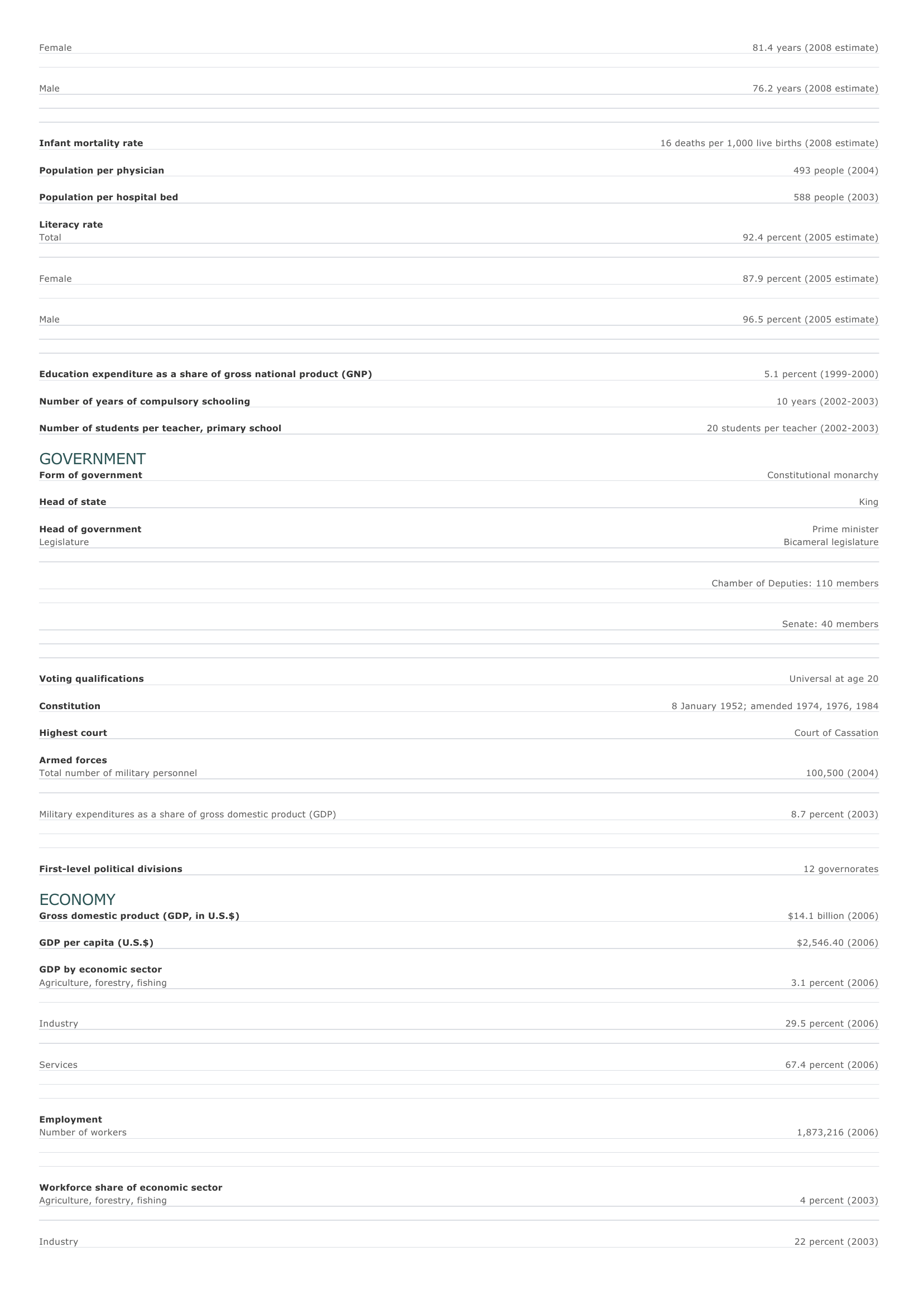Jordan Facts and Figures. BASIC FACTS Official name Capital Area Hashemite Kingdom of Jordan Amman 89,556 sq km 34,578 sq mi PEOPLE Population 6,198,677 (2008 estimate) Population growth Population growth rate 2.34 percent (2008 estimate) Projected population in 2025 8,651,714 (2025 estimate) Projected population in 2050 11,772,789 (2050 estimate) Population density 67 persons per sq km (2008 estimate) 175 persons per sq mi (2008 estimate) Urban/rural distribution Share urban 79 percent (2005 estimate) Share rural 21 percent (2005 estimate) Largest cities, with population A mman 1,237,000 (2003 estimate) Az Zarq? ' 428,623 (2000 estimate) Irbid 247,275 (2000 estimate) Al 'Aqabah 41,900 (1989 estimate) Ethnic groups Arab 98 percent Circassian 1 percent A rmenian 1 percent Languages Arabic (official), English widely understood among educated population Religious affiliations Muslim (Islam is the official religion; almost all Sunni Muslim) 93 percent Christian 4 percent Nonreligious 2 percent O ther 1 percent HEALTH AND EDUCATION Life expectancy Total 78.7 years (2008 estimate) Female 81.4 years (2008 estimate) Male 76.2 years (2008 estimate) Infant mortality rate 16 deaths per 1,000 live births (2008 estimate) Population per physician 493 people (2004) Population per hospital bed 588 people (2003) Literacy rate Total 92.4 percent (2005 estimate) Female 87.9 percent (2005 estimate) Male 96.5 percent (2005 estimate) Education expenditure as a share of gross national product (GNP) Number of years of compulsory schooling Number of students per teacher, primary school 5.1 percent (1999-2000) 10 years (2002-2003) 20 students per teacher (2002-2003) GOVERNMENT Form of government Head of state Head of government Legislature Constitutional monarchy King Prime minister Bicameral legislature Chamber of Deputies: 110 members Senate: 40 members Voting qualifications Constitution Highest court Universal at age 20 8 January 1952; amended 1974, 1976, 1984 Court of Cassation Armed forces Total number of military personnel Military expenditures as a share of gross domestic product (GDP) First-level political divisions 100,500 (2004) 8.7 percent (2003) 12 governorates ECONOMY Gross domestic product (GDP, in U.S.$) GDP per capita (U.S.$) GDP by economic sector Agriculture, forestry, fishing $14.1 billion (2006) $2,546.40 (2006) 3.1 percent (2006) I ndustry 29.5 percent (2006) Services 67.4 percent (2006) Employment Number of workers Workforce share of economic sector Agriculture, forestry, fishing I ndustry 1,873,216 (2006) 4 percent (2003) 22 percent (2003) Services Unemployment rate 74 percent (2003) 12.4 percent (2004) National budget (U.S.$) Total revenue $4,463 million (2006) Total expenditure $4,932 million (2006) Monetary unit 1 Jordanian dinar (Jd), consisting of 1,000 fil Major trade partners for exports Iraq, United States, India, Saudi Arabia, and Israel Major trade partners for imports Iraq, Germany, United States, China, and France ENERGY, COMMUNICATIONS, AND TRANSPORTATION Electricity production Electricity from thermal sources Electricity from hydroelectric sources Electricity from nuclear sources Electricity from geothermal, solar, and wind sources 99.41 percent (2003 estimate) 0.55 percent (2003 estimate) 0 percent (2003 estimate) 0.04 percent (2003 estimate) Number of radios per 1,000 people 271 (1997) Number of telephones per 1,000 people 119 (2004) Number of televisions per 1,000 people 119 (2000 estimate) Number of Internet hosts per 10,000 people 5.7 (2003) Daily newspaper circulation per 1,000 people 75 (1998) Number of motor vehicles per 1,000 people Paved road as a share of total roads 106 (2004) 100 percent (2004) SOURCES Basic Facts and People sections Area data are from the statistical bureaus of individual countries. Population, population growth rate, and population projections are from the United States Census Bureau, International Programs Center, International Data Base (IDB) (www.census.gov). Urban and rural population data are from the Food and Agriculture Organization (FAO) of the United Nations (UN), FAOSTAT database (www.fao.org). Largest cities population data and political divisions data are from the statistical bureaus of individual countries. Ethnic divisions and religion data are largely from the latest Central Intelligence Agency (CIA) World Factbook and from various country censuses and reports. Language data are largely from the Ethnologue, Languages of the World, Summer Institute of Linguistics International (www.sil.org). Health and Education section Life expectancy and infant mortality data are from the United States Census Bureau, International Programs Center, International database (IDB) (www.census.gov). Population per physician and population per hospital bed data are from the World Health Organization (WHO) (www.who.int). Education data are from the United Nations Educational, Scientific and Cultural Organization (UNESCO) database (www.unesco.org). Government section Government, independence, legislature, constitution, highest court, and voting qualifications data are largely from various government Web sites, the latest Europa World Yearbook, and the latest Central Intelligence Agency (CIA) World Factbook. The armed forces data is from Military Balance. Economy section Gross domestic product (GDP), GDP per capita, GDP by economic sectors, employment, and national budget data are from the World Bank database (www.worldbank.org). Monetary unit, agriculture, mining, manufacturing, exports, imports, and major trade partner information is from the statistical bureaus of individual countries, latest Europa World Yearbook, and various United Nations and International Monetary Fund (IMF) publications. Energy, Communication, and Transportation section Electricity information is from the Energy Information Administration (EIA) database (www.eia.doe.gov). Radio, telephone, television, and newspaper information is from the United Nations Educational, Scientific and Cultural Organization (UNESCO) database (www.unesco.org). Internet hosts, motor vehicles, and road data are from the World Bank database (www.worldbank.org). Note Figures may not total 100 percent due to rounding. Microsoft ® Encarta ® 2009. © 1993-2008 Microsoft Corporation. All rights reserved.



